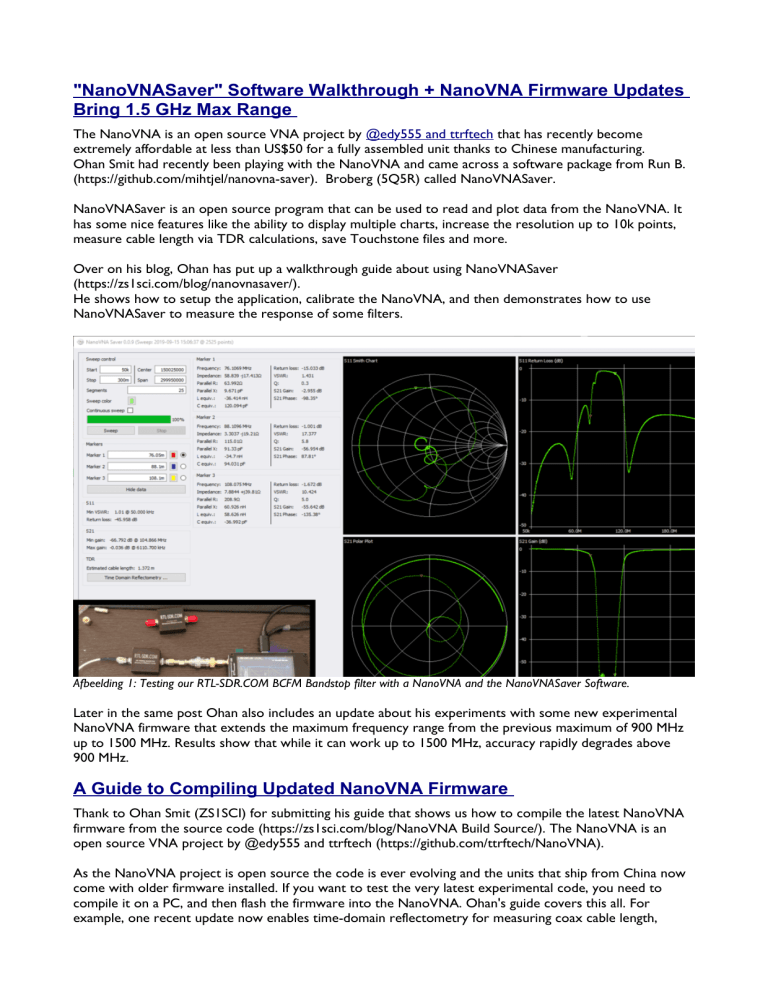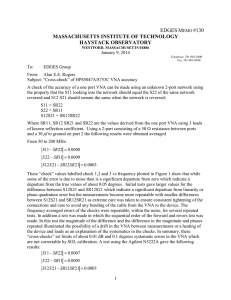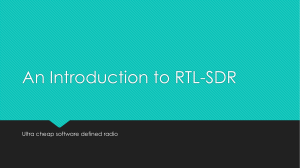
"NanoVNASaver" Software Walkthrough + NanoVNA Firmware Updates Bring 1.5 GHz Max Range The NanoVNA is an open source VNA project by @edy555 and ttrftech that has recently become extremely affordable at less than US$50 for a fully assembled unit thanks to Chinese manufacturing. Ohan Smit had recently been playing with the NanoVNA and came across a software package from Run B. (https://github.com/mihtjel/nanovna-saver). Broberg (5Q5R) called NanoVNASaver. NanoVNASaver is an open source program that can be used to read and plot data from the NanoVNA. It has some nice features like the ability to display multiple charts, increase the resolution up to 10k points, measure cable length via TDR calculations, save Touchstone files and more. Over on his blog, Ohan has put up a walkthrough guide about using NanoVNASaver (https://zs1sci.com/blog/nanovnasaver/). He shows how to setup the application, calibrate the NanoVNA, and then demonstrates how to use NanoVNASaver to measure the response of some filters. Afbeelding 1: Testing our RTL-SDR.COM BCFM Bandstop filter with a NanoVNA and the NanoVNASaver Software. Later in the same post Ohan also includes an update about his experiments with some new experimental NanoVNA firmware that extends the maximum frequency range from the previous maximum of 900 MHz up to 1500 MHz. Results show that while it can work up to 1500 MHz, accuracy rapidly degrades above 900 MHz. A Guide to Compiling Updated NanoVNA Firmware Thank to Ohan Smit (ZS1SCI) for submitting his guide that shows us how to compile the latest NanoVNA firmware from the source code (https://zs1sci.com/blog/NanoVNA Build Source/). The NanoVNA is an open source VNA project by @edy555 and ttrftech (https://github.com/ttrftech/NanoVNA). As the NanoVNA project is open source the code is ever evolving and the units that ship from China now come with older firmware installed. If you want to test the very latest experimental code, you need to compile it on a PC, and then flash the firmware into the NanoVNA. Ohan's guide covers this all. For example, one recent update now enables time-domain reflectometry for measuring coax cable length, which we explored in a previous post (https://www.rtl-sdr.com/calculating-coax-length-by-using-a-nanovnaas-a-time-domain-reflectometer/). Alternatively according to the GitHub readme, (https://github.com/ttrftech/NanoVNA) it is also possible to use a docker image which will remove the need to install the arm tool chain. Ready to flash images are also released every few days over on the GitHub release page, (https://github.com/ttrftech/NanoVNA/releases) although these won't include the very latest or experimental changes. Calculating Coax Length by using a NanoVNA as a Time-Domain Reflectometer Earlier in the month we posted about the NanoVNA, an open source VNA project by @edy555 and ttrftech that has recently become extremely affordable at US$50 for a fully assembled unit thanks to Chinese manufacturing. The NanoVNA comes with preinstalled software for it's LCD GUI, as well as a Windows program. However, the software is currently basic and doesn't implement everything possible with a VNA. Over on his blog, nuclearrambo has put up a post showing how to use the NanoVNA as a Time-domain reflectometer (TDR). A TDR allows you to measure coax cable length, and that can be useful for finding exactly where a suspected cable or connector fault is. Nucclearrambo provides a Python script which can be used with the NanoVNA's S1P output data to create a TDR graph. His tests with RG405 and LMR200 cable show that the length reported by the script comes remarkably close to the actual length. In addition to the above, Ohan Smit has extended on nuclearrambo's work by modifying the C# NanoVNA Windows software (which was reverse engineered by Roger Clark) to automatically run the TDR script when S1P data is saved. Future work could see the Windows program support TDR by default. Afbeelding 2: Using the NanoVNA as a Time Domain Reflectometer. Reviews of the NanoVNA: An Ultra Low Cost $50 Vector Network Analyzer A vector network analyzer (VNA) is an instrument that can be used to measure antenna or coax parameters such as SWR, impedance and loss. It can also be used to characterize and tune filters. It is a very useful tool to have if you are building and tuning home made antennas, filters or other RF circuits. For example if you are building a QFH or ADS-B antenna to use with an RTL-SDR, a VNA can help ensure that your antenna is properly tuned to the correct frequency. Compared to a standard SWR or network analyzer a VNA supplies you with phase information as well. Until just recently, VNA's have cost roughly US$500 for a decent USB PC based unit like the miniVNA or PocketVNA, and have set people back thousands to tens of thousands of dollars for bench top units. However, the cost of owning a VNA has now been reduced to only US$50 thanks to the NanoVNA. The open source NanoVNA project by @edy555 and ttrftech has been around since 2016, but only recently have Chinese sellers begun mass producing the unit and selling them on sites like Aliexpress, eBay and now Amazon. We note that it seems that there are some sellers selling them without shielding, so it might be worth double checking the listing to see if they mention that. All the listings we've seen seem to come with simple calibration kits as well. The NanoVNA is a small credit card sized VNA. It has a built in LCD screen that can be used to display graphs directly, or it can also be connected to a PC and the graphs viewed via the NanoVNA Windows software. When purchasing you can opt to include a small battery for portable operation for a few dollars extra. The frequency range is from 50 kHz to 900 MHz, although you should note that above 300 MHz dynamic range performance is reduced. Over on YouTube several hams and radio enthusiasts have recently uploaded videos demonstrating and reviewing the NanoVNA. The overall consensus is that the unit is accurate and works well. For additional support there is forum available at Groups.IO. https://www.rtl-sdr.com/tag/nanovna/ September 20, 2019




